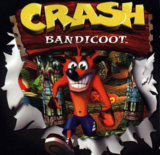Crash Bandicoot: a decent platformer hampered by bad ideas
I never played the inaugural entry in the Crash series when Playstation One was my primary console, but its two sequels, also released on the PSOne, are among my all-time favorite games. Coming back to the first title nearly twenty-years after its release certainly feels like a significant step back in terms of quality, but it does manage to inject feel-good nostalgia.
Crash is a creation of the evil Dr. Neo Cortex, originally intended to be a genetically modified super creature used by the wicked scientist to carry out diabolical tasks such as taking over the world. The orange marsupial is born to rebel, for he escapes from Cortex's lab soon after his inception, but he leaves behind a curvy female bandicoot named Tawna. Crash decides that he should go rescue her, and so the adventure begins.
The extreme linearity of the stages in the original Crash trilogy is one of its trademarks, but in the first game, it certainly feels like a drawback. The reason is that few ideas are implemented into the game to salvage it from repetition. Viewing Crash from the rear, you move him, typically, from the bottom of the screen forward. You can spin, head-bash, or jump onto crates along the way to collect fruits, extra lives, and bonus level icons. If you break every crate in any given stage, you will receive a silver gem for that level.
Certain levels slice the monotony, thankfully. There are times in which, in Indiana Jones fashion, Crash will have to run toward the screen, away from a boulder. He also rides a wild hog at high speeds through the jungle, dodging ridiculous obstacles along the way. Additionally, two-dimensional segments introduce a classic feel, and it is welcomed. The problem with most of the levels is that they only require skilled jumping to complete.
Yes, I know that this is a platformer, but remember that by 1996 the explorative Super Mario 64 and numerous ambitious platforming games from the Genesis/SNES era had pushed the limits of what could be done within a linear construct. There are instances in which you may ask yourself, "Haven't I played this level already?" That's because levels seem to recycle. Naughty Dog certainly broke boundaries of this layout with the next two Crash games, so a little more innovation within the stages was certainly doable here.
As repetitive as it is, the platforming itself is quite enjoyable, though annoying at times. For one, Crash is a clunky jumper; landing diagonal jumps can be tricky, and Crash's momentum is a problem since it cannot be reversed. If you over-jump a platform by just a smidgen, you missed and are dead. Another frustrating aspect of some levels are "gotcha" moments in which you are suddenly killed by something up ahead that you could not predict would be there. For example, you may be jumping along your merry way until you suddenly jump onto a platform--unforeseen until you jumped on it--that blazes up with flames every few seconds, and you are toast.
An uninspired set of enemies also look to stop Crash dead in his tracks, and they employ cheap "gotcha" tricks as well, suddenly and unexpectantly stinting your progress out of nowhere, in many instances. Spinning and jumping onto enemies make up for Crash's offense, and a blessed Native mask named Aku Aku gives him some defense. Aku Aku is basically a shield. He floats alongside Crash and absorbs the hit that the bandicoot would have taken. Collect three Aku Akus and Crash will wear the mask and become invincible as well as super fast and deadly, much like the star in Super Mario. It certainly makes offing these bland baddies quite fun.
The boss battles sure are nothing special, either: flimsy dodge-fest and pattern recognition galore. The difficulty of these encounters inconsistently rise and fall.. Boss number four was definitely easier than any before it.
Saving in your progress in Crash Bandicoot is far from easy, however; it is a challenge. Putting it bluntly, the save system is dumb. Every two levels or so, you enter a stage in which you may obtain three Tawna icons from crates. Once you do, you must conquer a small bonus stage. These bonus stages are not always a breeze, especially if you want to bust all of the crates in hopes of obtaining a silver gem for that level.
Located in the sky are these challenges, and if you fall, you lose and return to where you were when you found the third Tawna icon. Sadly, you are now deplete of any Tawna logos, and you must wait until you find three more before you have a chance to save again. Better hope you do not lose all of your lives before then, for you will end up back at the beginning of the stage in which you last saved your progress. Dumb.
This review seems overwhelmingly negative, yet I have given the game a positive score, so what are the redeeming qualities? Jumping and conquering crazy obstacles is simple, challenging, and fun. Graphically, Crash Bandicoot was a good-looking game for its time, and it is appreciable in retrospect. Bongos and other wild instrumentation, usually played in a calm or zany tone, make for a nice soundtrack, though it is not phenomenal by any means.
Crash Bandicoot 2: Cortex Strikes Back and Crash Bandicoot 3: Warped certainly improved upon the foundation that the first established. In those two games, like any good platformer I've played, I made it my goal to complete it one hundred percent. The nagging issues in this one kills my motivation to bash every crate. Nonetheless, a decent game is to be found here, and if only for nostalgic purposes at a fair price, Crash Bandicoot is worth revisiting.

